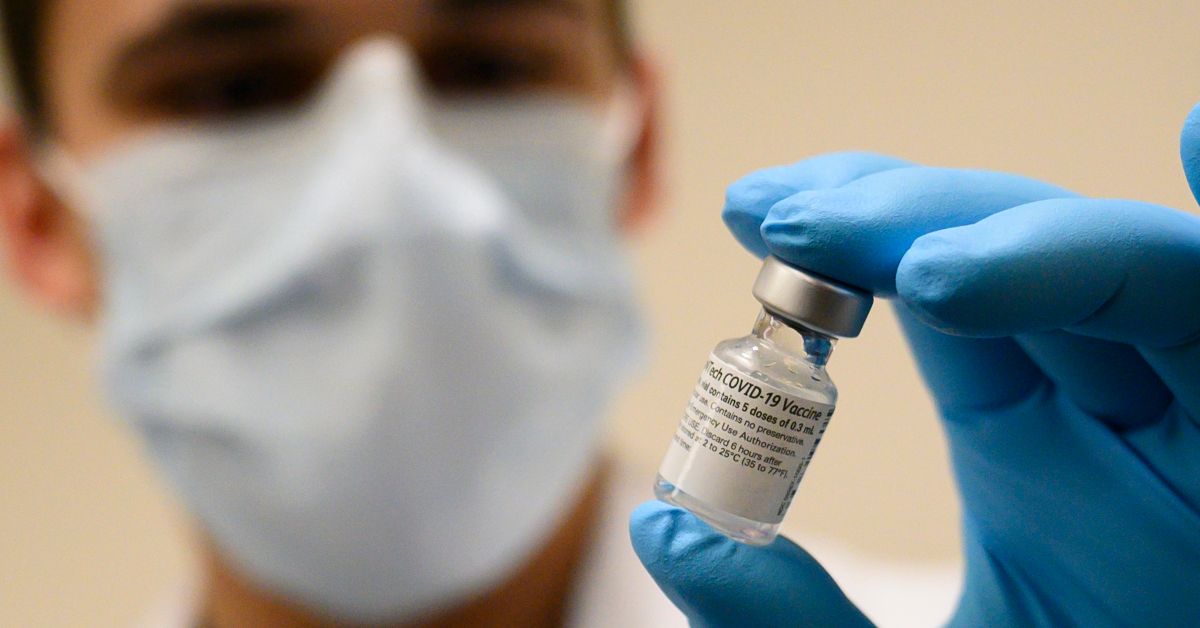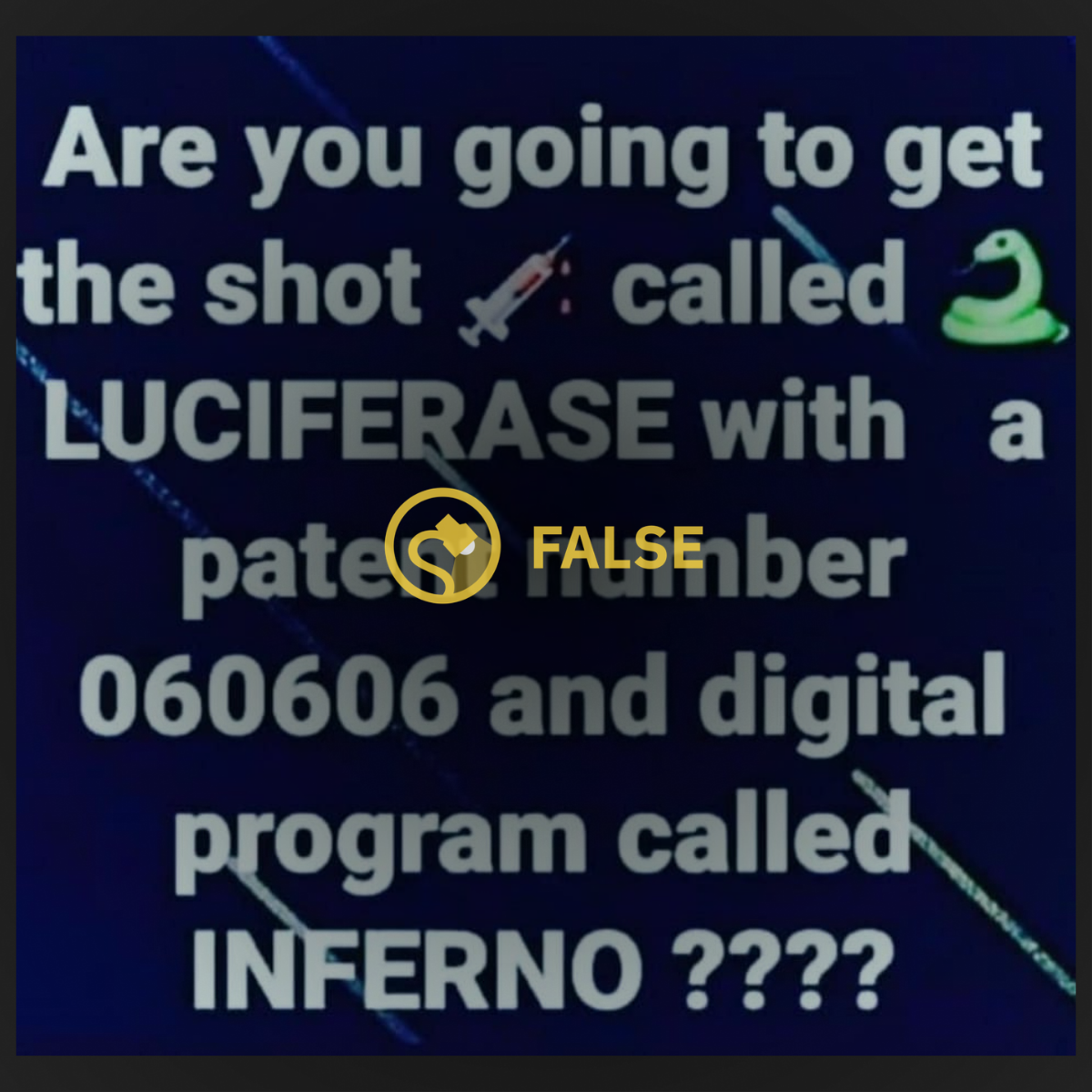In the spring of 2021, COVID-19 and vaccine conspiracy theorists enthusiastically shared a meme that claimed one or all of the COVID-19 vaccines available at that time were "called luciferase," and effectively warned readers not to accept them due to satanic connotations or associations.
The meme, shared widely on Facebook in March and April 2021, read as follows:
"Are you going to get the shot called LUCIFERASE with a patent number 060606 and digital program called INFERNO?"
Luciferase is a real scientific term that describes a group of naturally occurring enzymes that, under the correct conditions, cause the emission of light. However, the meme was grossly misleading and inaccurate in several ways: No COVID-19 vaccine is "called" luciferase, and no COVID-19 vaccine contains luciferase. Rather, luciferase has been used in some COVID-19-related research.
Furthermore, the concerns over the name of the enzyme were irrational and appeared to be based on a lack of understanding of the origins of the word. On the whole, we're issuing a rating of "False" as to the claim that COVID-19 vaccines are "called luciferase."
What Is Luciferase?
Luciferase refers to a group of enzymes (substances that trigger chemical reactions), which act upon a type of chemical compound called luciferins, with the result being bioluminescence — that is, the emission of light by a living organism. The most common example of the work of luciferase is found in fireflies.
Luciferase enzymes and luciferin compounds were discovered in the late 19th century by French scientist Raphaël Dubois. Their names are derived from the Latin roots "lux," meaning light, and "fero," meaning to bring or carry — thus, "light-bearing."
So, contrary to the misplaced fears of a satanic association or connotation underlying the meme, the "Lucifer" of the Christian tradition merely has the same etymological roots as "luciferase" enzymes and "luciferin" compounds.
No COVID-19 vaccine is "called luciferase" and neither do any of them contain the enzymes in question, as shown in the full ingredient lists for the Pfizer/BioNTech, Moderna, AstraZeneca, and Johnson & Johnson/Janssen vaccines.
In reality, the only link between luciferase and COVID-19 vaccines is that some research has used the enzymes to study issues related to COVID-19 and vaccine candidates. Because of the light-emitting properties of luciferase, they are useful in tracking biological processes.
In 2020, for example, researchers in the laboratory of Pei-Yong Shi at the University of Texas Medical Branch (UTMB) in Galveston used luciferase in both diagnosing the presence of COVID-19 antibodies in subjects, but also in testing the effectiveness of COVID-19 vaccine candidates. Texas Medical Center wrote at the time that:
Researchers harnessed luciferase to develop faster diagnostic testing through innovative assays—investigative procedures that measure the activity or amount of a substance. The lab can now visually confirm the presence of antibodies that can block a SARS-CoV-2 infection earlier than through previous methods.
...Shi said his team has been collaborating with leading pharmaceutical companies to help them evaluate their vaccine candidates, specifically by measuring the immune response in humans in clinical trials. His lab’s system—based on reporter viruses in which the luciferase enzyme is inserted into the virus’ genome to make it easy to follow—measures the concentration of neutralizing antibodies while also allowing for a much higher throughput. According to Xuping Xie, Ph.D., assistant professor in the department of biochemistry and molecular biology at UTMB, this way of measuring the immune response is more accurate than traditional methods.
“The sensitivity and the dynamics of the assay, because of the luciferase, can really allow us to discern any small changes that the conventional way would not,” said Xie. “It’s much more sensitive, much more accurate, when you test antiviral compounds.”
Researchers at the University of South Florida also used luciferase to track the effect and spread of the COVID-19 virus within the body. Tom McDonald explained the research as follows:
It’s a good surrogate for whether or not the virus can get into a particular cell type, and you can actually quantify it. You say it gets in more, it gets in less, that type of comparison is easily made with the firefly luciferase.
Dr. McDonald explains by adding that virus to lung, heart, and vascular cells, they can see how well the virus gets into those cells and which ones are vulnerable.
“When you have this, they glow in the dark,” said McDonald. “You don’t have any background noise here so that your ability to precisely quantify how much of the virus is getting in by this technique is very precise.”
The second component of the meme — the claim that COVID-19 vaccines have a "patent number 060606" — is also inaccurate and one we have examined in greater detail previously.


